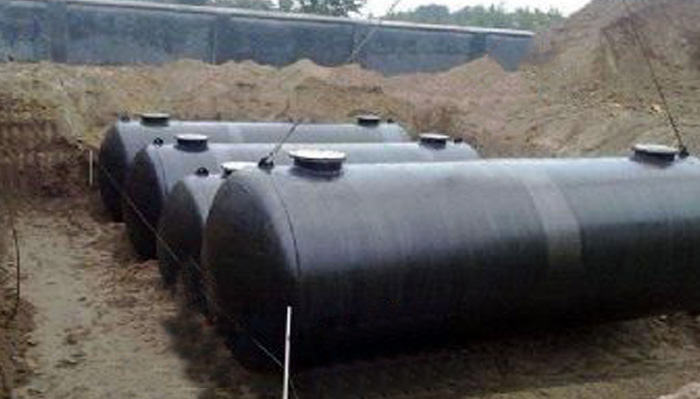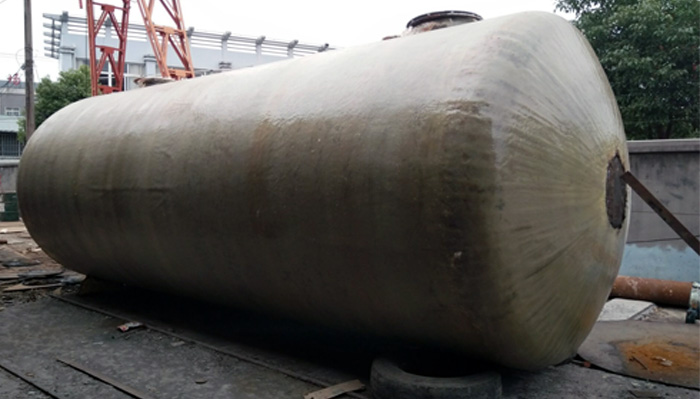Product Category
Precautions for unloading the double layer oil storage tank
Date: Mar 30, 2020

Precautions for double-layer oil tank unloading
1. First of all, we must measure the double-layer oil tank before unloading, and check the oil storage capacity of the tank before unloading, so as to prevent the top from running when the oil is unloaded. When unloading the oil, the flow of oil must be strictly controlled. Before the oil is not submerged into the oil pipe, the flow rate of the oil should be controlled within 0.71m / s to prevent static electricity.
2. Secondly, the user should also have someone to monitor when unloading the pressure vessel. The driver should first connect the temporary grounding wire at the specified location of the tanker truck, and stick to his post to prevent pedestrians from approaching. After the oil tank is unloaded, after 5 minutes of oil stabilization, check the oil tank inventory again to prevent electrostatic discharge between the oil level gauge and the oil level, and between the oil tanks, causing a major disaster.
3. Do a good job of safety protection. The exhaust pipe of the oil tanker should be installed with a fireproof cover. The engine should be turned off during gravity discharge. At the same time, stop the refueling operation (except the tank area and the refueling area are separated), do a safety alert, and arrange the unloading in time.
4. One more thing to note is that when unloading a double-layer oil tank, you need to pay attention that the oil pipe should reach to the bottom of the tank not more than 300mm to prevent static electricity from splashing into the oil. According to the experience of some regions, changing a section of oil discharge pipe entering the oil tank area into a flower pipe can prevent oil splashing.
Oil tank cleaning precautions
1. Double-layer oil tank cleaning personnel must pass the safety training before they can start work;
2. The tank cleaning personnel must clearly understand the possible risk factors during construction;
3. Before construction of the pressure vessel tank area, check and understand the site, warning signs, fire protection facilities, and check whether the equipment is intact, whether it meets explosion-proof requirements, and whether there is static grounding. The cleaning site must be supervised by a person
4. The equipment should be far away from the tank, and no flammable or explosive materials should appear on the site; 5. Personnel cleaning oil tanks shall wear uniform antistatic work clothes, shoes, hats and gloves, and chemical fiber clothing is strictly prohibited;
5. Personnel cleaning oil tanks shall wear uniform antistatic work clothes, shoes, hats and gloves, and chemical fiber clothing is strictly prohibited;
6. When cleaning residual oil, do not use iron or steel tools that are prone to sparks;
7. When personnel are performing double-layer oil tank cleaning operations, they need to strengthen ventilation and eliminate harmful gases;
8. During cleaning, the oily water in the tank is pumped to other tanks for temporary storage or directed outside the reservoir area for processing. The sludge and iron filings under the deposition should be buried in time, or they will stick together after cooling, which is more difficult to handle;
9. Use a three-dimensional nozzle for cleaning. If the container is relatively large and the cleaning is not comprehensive enough, we can configure the nozzle extension rod for use;
10. After cleaning the pressure vessel, natural ventilation is required. All openable hole covers on the oil tank should be opened for natural ventilation for 7-10 days, and forced ventilation can also be carried out with a ventilator.
1. First of all, we must measure the double-layer oil tank before unloading, and check the oil storage capacity of the tank before unloading, so as to prevent the top from running when the oil is unloaded. When unloading the oil, the flow of oil must be strictly controlled. Before the oil is not submerged into the oil pipe, the flow rate of the oil should be controlled within 0.71m / s to prevent static electricity.
2. Secondly, the user should also have someone to monitor when unloading the pressure vessel. The driver should first connect the temporary grounding wire at the specified location of the tanker truck, and stick to his post to prevent pedestrians from approaching. After the oil tank is unloaded, after 5 minutes of oil stabilization, check the oil tank inventory again to prevent electrostatic discharge between the oil level gauge and the oil level, and between the oil tanks, causing a major disaster.
3. Do a good job of safety protection. The exhaust pipe of the oil tanker should be installed with a fireproof cover. The engine should be turned off during gravity discharge. At the same time, stop the refueling operation (except the tank area and the refueling area are separated), do a safety alert, and arrange the unloading in time.
4. One more thing to note is that when unloading a double-layer oil tank, you need to pay attention that the oil pipe should reach to the bottom of the tank not more than 300mm to prevent static electricity from splashing into the oil. According to the experience of some regions, changing a section of oil discharge pipe entering the oil tank area into a flower pipe can prevent oil splashing.
Oil tank cleaning precautions
1. Double-layer oil tank cleaning personnel must pass the safety training before they can start work;
2. The tank cleaning personnel must clearly understand the possible risk factors during construction;
3. Before construction of the pressure vessel tank area, check and understand the site, warning signs, fire protection facilities, and check whether the equipment is intact, whether it meets explosion-proof requirements, and whether there is static grounding. The cleaning site must be supervised by a person
4. The equipment should be far away from the tank, and no flammable or explosive materials should appear on the site;

6. When cleaning residual oil, do not use iron or steel tools that are prone to sparks;
7. When personnel are performing double-layer oil tank cleaning operations, they need to strengthen ventilation and eliminate harmful gases;
8. During cleaning, the oily water in the tank is pumped to other tanks for temporary storage or directed outside the reservoir area for processing. The sludge and iron filings under the deposition should be buried in time, or they will stick together after cooling, which is more difficult to handle;
9. Use a three-dimensional nozzle for cleaning. If the container is relatively large and the cleaning is not comprehensive enough, we can configure the nozzle extension rod for use;
10. After cleaning the pressure vessel, natural ventilation is required. All openable hole covers on the oil tank should be opened for natural ventilation for 7-10 days, and forced ventilation can also be carried out with a ventilator.
Next article:
Send Your Inquiry
We not only provide a good product, but also provide high quality service. If you are interested in our products,
you can contact us in the following ways.
you can contact us in the following ways.















































































































